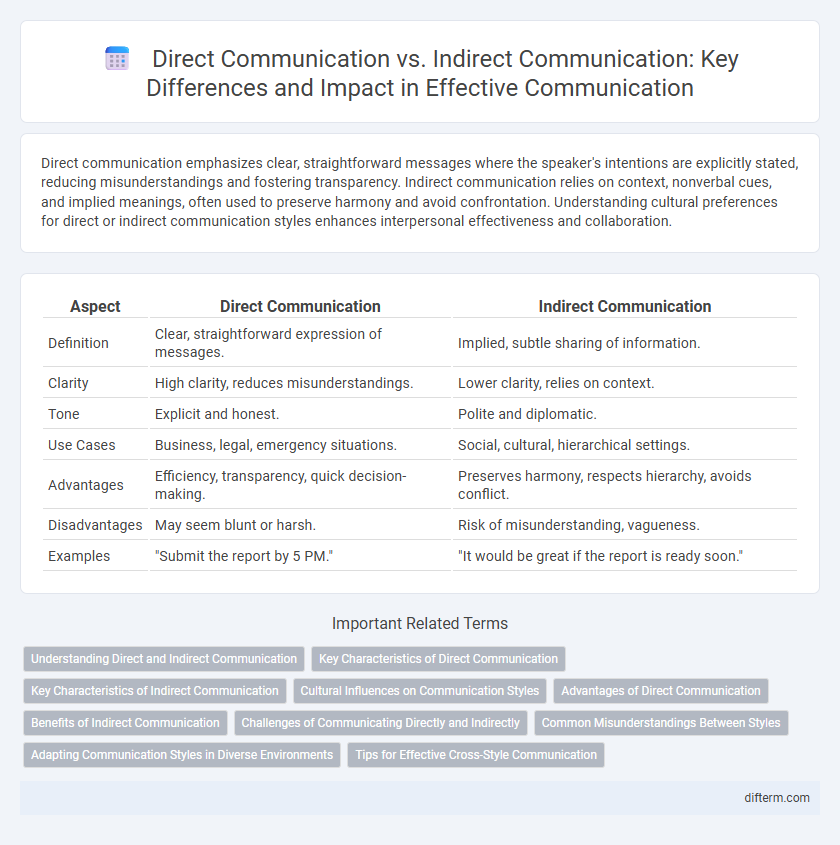Direct communication emphasizes clear, straightforward messages where the speaker's intentions are explicitly stated, reducing misunderstandings and fostering transparency. Indirect communication relies on context, nonverbal cues, and implied meanings, often used to preserve harmony and avoid confrontation. Understanding cultural preferences for direct or indirect communication styles enhances interpersonal effectiveness and collaboration.
Table of Comparison
| Aspect | Direct Communication | Indirect Communication |
|---|---|---|
| Definition | Clear, straightforward expression of messages. | Implied, subtle sharing of information. |
| Clarity | High clarity, reduces misunderstandings. | Lower clarity, relies on context. |
| Tone | Explicit and honest. | Polite and diplomatic. |
| Use Cases | Business, legal, emergency situations. | Social, cultural, hierarchical settings. |
| Advantages | Efficiency, transparency, quick decision-making. | Preserves harmony, respects hierarchy, avoids conflict. |
| Disadvantages | May seem blunt or harsh. | Risk of misunderstanding, vagueness. |
| Examples | "Submit the report by 5 PM." | "It would be great if the report is ready soon." |
Understanding Direct and Indirect Communication
Direct communication involves explicitly stating messages, ensuring clarity and minimizing misunderstandings, which is crucial in fast-paced or task-oriented environments. Indirect communication relies on context, tone, and non-verbal cues to convey meaning, often used in cultures prioritizing harmony and relationship preservation. Understanding the nuances between direct and indirect communication styles enhances cross-cultural interactions and improves overall effectiveness in both personal and professional settings.
Key Characteristics of Direct Communication
Direct communication is characterized by clear, straightforward messages that leave little room for ambiguity or misinterpretation. It involves explicit verbal expressions where the speaker's intentions, opinions, and requests are openly stated, emphasizing transparency and efficiency. This communication style prioritizes honesty and clarity, often used in professional settings to enhance decision-making and reduce misunderstandings.
Key Characteristics of Indirect Communication
Indirect communication relies heavily on context, nonverbal cues, and implied meanings rather than explicit language, making it essential for conveying subtle messages in high-context cultures. It often involves politeness strategies, ambiguity, and the use of metaphors or storytelling to preserve harmony and avoid conflict. Understanding the nuances of tone, body language, and cultural norms is crucial for accurately interpreting indirect communication.
Cultural Influences on Communication Styles
Cultural influences significantly shape communication styles, leading to variations between direct and indirect communication across societies. High-context cultures, such as Japan and Saudi Arabia, often rely on indirect communication, using implicit messages and non-verbal cues to maintain harmony and avoid confrontation. In contrast, low-context cultures like the United States and Germany favor direct communication, emphasizing clarity and explicit expression to ensure understanding and efficiency.
Advantages of Direct Communication
Direct communication enhances clarity by reducing misunderstandings and promoting straightforward information exchange. It fosters quicker decision-making and problem-solving due to transparent feedback and explicit expectations. Organizations adopting direct communication often experience increased trust and stronger team collaboration, optimizing overall productivity.
Benefits of Indirect Communication
Indirect communication fosters a more harmonious environment by minimizing conflicts and preserving relationships through subtlety and tact. It allows individuals to convey sensitive messages without causing offense, thereby enhancing emotional intelligence and cultural sensitivity. This approach is particularly beneficial in high-context cultures where maintaining group cohesion and face-saving are paramount.
Challenges of Communicating Directly and Indirectly
Direct communication often challenges individuals with its potential for perceived bluntness or confrontation, risking misunderstandings and strained relationships. Indirect communication can lead to ambiguity and confusion, as messages may be vague or reliant on context cues, making it difficult to ascertain the speaker's true intent. Both styles require cultural sensitivity and emotional intelligence to navigate misunderstandings and ensure effective information exchange.
Common Misunderstandings Between Styles
Direct communication emphasizes clarity and explicitness, while indirect communication relies on context and nonverbal cues, often leading to misunderstandings between the two styles. Individuals accustomed to indirect communication may perceive direct communicators as blunt or rude, whereas direct communicators might view indirect communicators as evasive or ambiguous. These divergent expectations can cause misinterpretations, reducing the effectiveness of interpersonal interactions in multicultural or diverse settings.
Adapting Communication Styles in Diverse Environments
Adapting communication styles in diverse environments requires recognizing when to use direct communication, which emphasizes clarity and precision, versus indirect communication, which relies on context and subtlety to convey meaning. Understanding cultural norms, such as high-context cultures valuing indirect methods and low-context cultures preferring directness, enhances interpersonal effectiveness and reduces misunderstandings. Mastering this balance improves collaboration and fosters inclusive, respectful exchanges in global and multicultural settings.
Tips for Effective Cross-Style Communication
Adapting to different cultural communication styles enhances clarity and mutual understanding in cross-style interactions. Use active listening and ask clarifying questions to ensure messages are accurately interpreted between direct and indirect communicators. Emphasize nonverbal cues and context to bridge gaps and foster respectful, effective dialogue.
direct communication vs indirect communication Infographic

 difterm.com
difterm.com